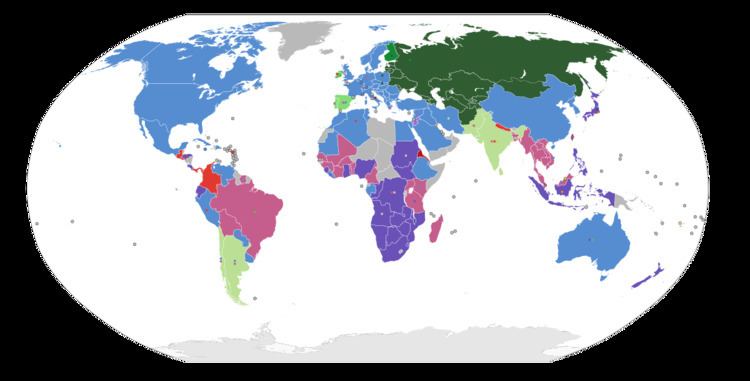Track gauge conversions include:
During World War I and World War II, gauge conversion occurred backwards and forwards between Germany and Russia as the fronts and national borders chopped and changed.
The list also contains
proposed conversions
preparations for conversions
Melbourne to Adelaide – 600 km (370 mi) of convertible sleepers installed in 1990 to facilitate quick conversion in 1995.
Adelaide – convertible sleepers installed should gauge conversion be needed in future.
Port Harcourt – Onne, Nigeria – convertible sleepers installed since gauge conversion not imminent.
The Mount Gambier line in South Australia was fitted with some 3-gauge steel sleepers when it was "temporarily" converted from 1,067 mm (3 ft 6 in) to 1,600 mm (5 ft 3 in) in the 1950s, pending later proposed conversion to 1,435 mm (4 ft 8 1⁄2 in), which is yet to occur.
Central Asia – while China and Europe are connected by rail, and while both are mainly 1,435 mm (4 ft 8 1⁄2 in), the intervening Central Asia Railways are 1,520 mm (4 ft 11 27⁄32 in) gauge. Intervening lines are gradually being made gauge convertible to facilitate an eventual linkage of the Chinese and European standard gauge system. (variable gauge trains)
Tanzania in 2008 is proposing 1,000 mm (3 ft 3 3⁄8 in)/1,067 mm (3 ft 6 in) steel sleepers and 1,000 mm (3 ft 3 3⁄8 in)/1,435 mm (4 ft 8 1⁄2 in) concrete sleepers to suit gauge conversion.
India conversion of 17,000 km (11,000 mi) of 1,000 mm (3 ft 3 3⁄8 in) gauge to 1,676 mm (5 ft 6 in) broad gauge under project Unigauge
Melbourne to Adelaide – 600 km (370 mi) of convertible sleepers installed in 1990 to facilitate quick conversion in 1995.
Adelaide – convertible sleepers installed should gauge conversion be needed in future.
Port Harcourt – Onne, Nigeria – convertible sleepers installed since gauge conversion not imminent.
The Mount Gambier, South Australia line was fitted with some 3-gauge steel sleepers when it was "temporarily" converted from 1,067 mm (3 ft 6 in) to 1,600 mm (5 ft 3 in) in the 1950s, pending later proposed conversion to 1,435 mm (4 ft 8 1⁄2 in), which is yet to occur.
Central Asia – while China and Europe are connected by rail, and while both are mainly 1,435 mm (4 ft 8 1⁄2 in), the intervening Central Asia Railways are 1,520 mm (4 ft 11 27⁄32 in) gauge. Intervening lines are gradually been made gauge convertible to facilitate and eventual linkage of the Chinese and European standard gauge system.
Tanzania in 2008 is proposing 1,000 mm (3 ft 3 3⁄8 in)/1,067 mm (3 ft 6 in) steel sleepers and 1,000 mm (3 ft 3 3⁄8 in)/1,435 mm (4 ft 8 1⁄2 in) concrete sleepers to suit gauge conversion.
A Russian broad gauge line reaches out into Slovakia to carry minerals without the need for transshipment which would be required if the gauge changed at the border. In 2008, it is proposed to extend this line to Vienna. On 9 April 2010, a four-way deal was signed. As a general rule, transshipment is minimised if breaks-of-gauge occur at or near major hubs or major origins and destinations of traffic.
4-6-4 R766 of the Victorian Railways, Australia, being designed for ease of conversion from 1,600 mm (5 ft 3 in) to 1,435 mm (4 ft 8 1⁄2 in), was so converted.
The 1,600 mm (5 ft 3 in) gauge Oaklands railway line was converted to standard gauge to avoid becoming an orphan when the Seymour-Albury line was also converted fully to standard gauge.
In Western Australia, the iron ore railways serving or to serve Geraldton port, and the new port at Oakajee are narrow gauge, but will be designed for ease of conversion to standard gauge.
In Victoria several wheat lines, amounting to about 1100km of track, are to be converted to standard gauge, including:
Maryborough to Mildura, Yelta and Murrayville ; Sea Lake and Manangatang.
Converted to dual gauge between Gheringhap to Maryborough.

